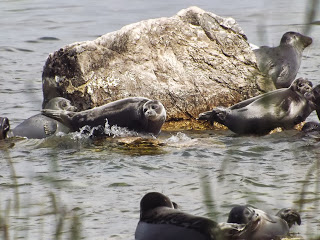

We departed BK at 9:45 this morning, waving from the Kozhov until we
could no longer see our beloved Russian and NSF friends who kindly
gathered to see us off. We left without ever seeing the other side of
the Lake from the Biostation -- some of us find it hard to believe
that it is even possible. BK wept with us as a drizzle cemented our
departure, obscuring the town from view only meters into our journey.
About an hour later we docked in Listvianka, funnily enough right next
to the Vershina, the boat that half of us, the "nerpas," took on the
expedition. In Listvianka we did lots of open-air souvenir shopping,
primarily for the purple stone Charoite found only in the North-East
Irkutsk region. We had a wonderful bagged lunch from BK on the Irkutsk
State Bus, as we bumped and braved the traffic to the Siberian
architecture museum in Tal'tsy. Tal'tsy is situated on the Angara
River, between Listvianka and Irkutsk. There, we saw Siberian houses
of the 17th through 20th centuries from the Lake Baikal region that
were moved, log by log, to Tal'tsy to avoid flooding by the damming of
the Angara river in the late 60s. We were treated to elaborate stories
of times past, of the Cossacks, the Buryats, and the Evenks. A
performance by a musician on the Ukrainian bandura, what can be
described quite accurately as a combination of a guitar and a harp in
one instrument, was agreed upon as a highlight of the tour. Another
was the excellent selections of folk crafts for sale, which many of us
purchased, such as carved Siberian cedar (Pinus sibericus) cooking
utensils, wild rhododendron tea, and carved birch accessories, as well
as many others. We finished off our visit with a ride on Russian
Swings, large logs which allowed to riders to propel themselves far
into the air. It was exhilarating!
We sadly said goodbye to our hosts in Tal'tsy, and continued on the
highway to Irkutsk. Suddenly we found ourselves in the same place
where our journey began -- our Irkutsk State University dormitory. We
spent the afternoon getting comfortable again, resting, and enjoying a
wonderful supper together. We look forward to a full day of Irkutsk
culture and sight-seeing tomorrow.
Kate and Lily














































